How to decrypt SSL with Wireshark
Step one – set up an SSL-protected server to use as a testbedTo illustrate the process, we’re going to use OpenSSL to generate a certificate and act as a web server running HTTP over SSL (aka HTTPS) – it’s quite straightforward.
To begin with, we need to get ourselves a self-signed certificate that our HTTPS server can use. We can do this with a single command:
openssl req -x509 -nodes -newkey rsa:1024 -keyout testkey.pem -out testcert.pem
OpenSSL will ask you for some input to populate your certificate with; once you’ve answered all the questions, the output of this command is two files, testkey.pem (containing a 1024 bit RSA private key) and testcert.pem (containing a self signed certificate). PEM (Privacy Enhanced Mail) format files are plaintext, and consist of a BASE64 encoded body with header and footer lines. You can look at the contents of your key and certificate files in more detail like this:
openssl rsa -in testkey.pem -text -noout (output here)
openssl x509 -in testcert.pem -text -noout (output here; more info here)
We need to perform one tiny tweak to the format of the private key file (Wireshark will use this later on, and it won’t work properly until we’ve done this):
openssl rsa -in testkey.pem -out testkey.pem
Now we’re ready to fire up our HTTPS server:
openssl s_server -key testkey.pem -cert testcert.pem -WWW -cipher RC4-SHA -accept 443
The -key and -cert parameters to the s_server command reference the files we’ve just created, and the -WWW parameter (this one is case sensitive) causes OpenSSL to act like a simple web server capable of retrieving files in the current directory (I created a simple test file called myfile.html for the purposes of the test).
The -cipher parameter tells the server to use a particular cipher suite – I’m using RC4-SHA because that’s what’s used when you go to https://www.google.com. The RC4-SHA cipher suite will use RSA keys for authentication and key exchange, 128-bit RC4 for encryption, and SHA1 for hashing.
Having got our server up and running, we can point a browser at https://myserver/myfile.html and retrieve our test file via SSL (you can ignore any warnings about the validity of the certificate). If you’ve got this working, we can move on to…
Step two – capture some traffic with Wireshark
Fire up Wireshark on the server machine, ideally with a capture filter like “tcp port 443″ so that we don’t capture any unnecessary traffic. Once we’re capturing, point your browser (running on a different machine) at https://myserver/myfile.html and stop the capture once it’s complete.
Right-click on any of the captured frames and select “Follow TCP stream” – a window will pop up that’s largely full of SSL-protected gobbledegook:

Step three – configuring Wireshark for decryption
Close the TCP Stream window and select Preferences from Wireshark’s Edit menu. Expand the “Protocols” node in the tree on the left and scroll down to SSL (in newer versions of Wireshark, you can open the node and type SSL and it will take you there).
Once SSL is selected, there’s an option on the right to enter an “RSA keys list”. Enter something like this:
10.16.8.5,443,http,c:\openssl-win32\bin\testkey.pem
You’ll need to edit the server IP address and path to testkey.pem as appropriate. If this has worked, we’ll notice two things:
- Wireshark’s SSL dissector can look into otherwise encrypted SSL packets and dissect the protocol inside:

- We can right-click on any of the captured frames that are listed as SSL or TLS and select “Follow SSL stream”:

You can read about this step in the Wireshark Wiki here.
Why it works
So, why does this work? Our test server, in common with a very large proportion of HTTP-over-SSL webservers, is using RSA to exchange the symmetric session key that will be used by the encryption algorithm (RC4 in this case). Below is an extract from RFC2246:F.1.1.2. RSA key exchange and authenticationThe server can of course decrypt the pre_master_secret passed to it by the client (by using the server’s private key in testkey.pem), and subsequently both the client and the server derive the master_secret from it – this is the symmetric key that both parties will use with RC4 to encrypt the session.
With RSA, key exchange and server authentication are combined. The public key may be either contained in the server’s certificate or may be a temporary RSA key sent in a server key exchange message.
After verifying the server’s certificate, the client encrypts a pre_master_secret with the server’s public key.
But the server isn’t the only one with the private key that corresponds to the public key in the server’s certificate – Wireshark has it as well. This means it is able to decrypt the pre_master_secret on its way from the client to the server, and thereafter derive the master_secret needed to decrypt the traffic.
No comments:
Post a Comment